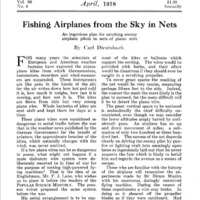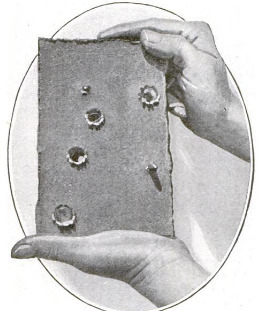Bullets That Shoot Through Steel
Item
-
Title (Dublin Core)
-
Bullets That Shoot Through Steel
-
Article Title and/or Image Caption (Dublin Core)
-
Bullets That Shoot Through Steel. Medieval armor was revived, but it now bids fair to become once more obsolete
-
Caption: Effect of armor-piercing bullets. The revival of medieval armor as a protective measure has been one of the interesting sidelights in the present war. The first serious adoption was the steel shrapnel helmets, and since that time armor has been used more and more. Now, however, means have been discovered to pierce it and it would seem that it is about due to be once more relegated to the limbo of obsolete things. What will the next revival be?
-
extracted text (Extract Text)
-
BRITISH sniper lay behind his
shield of quarter-inch hardened
"steel at the Ypres salient and
smiled when a bul-
let from a vigilant
German sniper
crashed against the
protection. He
knew that nothing
less than a couple of
shells from some far-
off field gun could
bother him. When
the next shot came,
the smile faded from
his lips. ~~ After dark
he crawled painfully
back to his trench-
line, shot through
the left shoulder. In
the shield, which
would turn a bullet
at the very muzzle,
there was a neat
round hole, less than
one-quarter of an
inch in diameter and
therefore smaller
than the service bul-
let of the German
rifle. From the
shoulder the sur-
geons took the mis-
sile, a bullet made of solid steel, boat-
shaped, with sharp point and tapered
tail, and harder than glass. From other
bullets of the sort, fired by the Germans
for special occasions, the British were
able to reconstruct the whole bullet.
Inside the German bullet, with its cus-
tomary mild steel jacket—instead of the
copper-nickel jacket used by the Ameri-
cans and British for the same purpose—
and inside a coating of lead, there lay a
miniature bullet of steel, which the sur-
geons took from the sniper’s shoulder and
which had gone through the supposed
bullet-proof shield.
Fired from the Mauser rifle of the Ger-
man, the mild steel jacket and the lead
covering of the steel bullet inside, yielded
enough to take the rifling of the barrel,
and the bullet flew through the air like
any other bullet. When it struck steel,
the leaden covering,
and the thin steel
jacket supported the
steel point of the
bullet within for a
short instant, then
they spattered into
a spray of molten
lead and fragments
of jacket, and the
steel bullet traveled
on alone through the
steel plate.
This is the prin-
ciple of the armor-
piercing bullet that
is coming to be so
common among the
fighting armies of
the world.
The corresponding
American bullet is
the Clay, invented
by Captain W. L.
Clay of our Ord-
nance Department.
Tt is superior to any
of the armor piercers
made abroad.
Through the econ-
struction of its point it will not glance off
even the most inclined hardened steel
surfaces, for armor surfaces are sloped
when possible, to avoid a direct hit on the
armor, and to make the bullet glance off
harmlessly.
The Clay bullet has the jacket cut away
for the last eighth of an inch at the point,
exposing the soft lead. This in turn
smashes down on striking, changing the
shape of the point and making the bullet
“bite” on the hard, inclined surface.
Then the hard steel bullet within comes
smashing through, while the lead and the
jacket fly off in spray and fragments,
their work done. The actual killing or
wounding is done, of course, by the little
steel bullet inside of the ordinary one.
-
Language (Dublin Core)
-
eng
-
Date Issued (Dublin Core)
-
1918-04
-
pages (Bibliographic Ontology)
-
599
-
Rights (Dublin Core)
-
Public Domain (Google digitized)
-
Archived by (Dublin Core)
-
Filippo Valle
-
Alberto Bordignon (Supervisor)
 Popular Science Monthly, v. 92, n. 4, 1918
Popular Science Monthly, v. 92, n. 4, 1918



